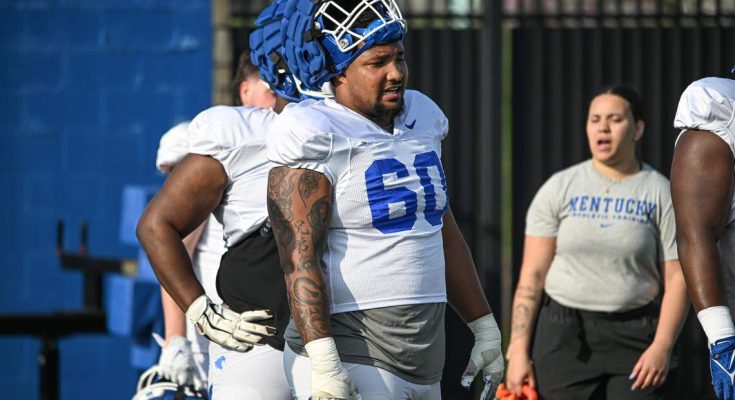Kentucky football has long been a program in search of consistency and a true identity within the highly competitive landscape of the SEC. For decades, the Wildcats have flirted with success, producing occasional standout seasons, thrilling victories, and unforgettable moments that have energized the fan base. Yet, the program has also struggled to maintain momentum, often falling short when it matters most, particularly against elite competition. In recent years, one of the most glaring challenges has been the team’s inability to consistently protect its quarterback and establish a dominant offensive line—a problem that has hindered offensive efficiency, limited playmaking potential, and contributed to untimely losses. Now, however, there are strong indications that Kentucky football is actively addressing this critical issue, investing resources, talent, and strategy into fixing what has long been its biggest weakness. The steps being taken suggest a program committed to meaningful growth, with a vision that could reshape the trajectory of the Wildcats for the better.
Historically, Kentucky’s offensive line has been a point of vulnerability. In seasons where the Wildcats have shown promise, the offensive line has often struggled to provide consistent protection, particularly against SEC defenses that are among the most physically imposing and tactically disciplined in college football. Quarterbacks have faced relentless pressure, leading to hurried throws, sacks, turnovers, and, ultimately, stalled drives. Running backs have struggled to find lanes, and offensive coordinators have been forced to adapt their schemes to compensate for line deficiencies, rather than having the freedom to execute their preferred game plans. These limitations have created a ripple effect across the offense, impacting rhythm, timing, and confidence, while making it difficult for Kentucky to compete at the highest level week after week.
Recognizing that a strong offensive line is foundational to success, Kentucky’s coaching staff has taken deliberate measures to improve in this area. Recruiting has been a critical focal point, with the program targeting high-caliber linemen who combine size, athleticism, and technical skill. By emphasizing recruiting in areas known for producing top-tier offensive line talent, the Wildcats have increased their chances of securing players capable of competing immediately at the SEC level. Moreover, the program has demonstrated a commitment to not only acquiring talent but also developing it. Strength and conditioning programs have been tailored to enhance linemen’s power, agility, and endurance, while position-specific coaching emphasizes technique, leverage, and mental preparation for the complexities of SEC defensive schemes. The holistic approach to developing offensive linemen shows that Kentucky is serious about long-term solutions rather than temporary fixes.
In addition to recruiting and development, Kentucky has also made strategic adjustments to its offensive schemes to better protect the quarterback and create opportunities for the running game. Coaching staff have incorporated more quick-release passing concepts, designed rollouts, and emphasized pre-snap reads that allow quarterbacks to make faster, smarter decisions. Running schemes have been adapted to exploit defensive tendencies, create favorable matchups, and utilize the athleticism of the offensive line to open lanes effectively. These tactical adjustments complement the improvements being made in recruiting and player development, creating a more balanced approach that addresses the issue from multiple angles.
Perhaps equally important is the culture being cultivated within the offensive line room and across the team as a whole. Kentucky football has placed a premium on accountability, resilience, and cohesion. Offensive linemen are expected to operate not just as individuals, but as a synchronized unit that understands each other’s strengths and weaknesses. Communication, trust, and discipline have become key components of practice and game preparation, reinforcing the idea that a strong line is built as much on chemistry and mental toughness as it is on raw talent. By instilling these values early and consistently, Kentucky is creating a foundation that can sustain success even as players cycle through the program.
The early signs of progress are evident in practice reports and spring evaluations, where Kentucky’s offensive line has shown improved technique, better communication, and a more physical presence at the point of attack. Analysts and insiders have noted that the team appears more confident in both pass protection and run blocking, suggesting that the work being done off the field is translating into tangible results on it. This improvement has a cascading effect on the entire offense, as quarterbacks can operate with more confidence, running backs can find and exploit gaps more consistently, and the play-calling becomes less constrained by fear of pressure or penetration.
Beyond the technical aspects, addressing the offensive line problem has significant implications for recruiting and program perception. High school prospects are more likely to commit to a program that demonstrates a clear pathway to success, particularly at positions as critical as the offensive line. By showing that Kentucky is serious about building a strong foundation and prioritizing player development, the program enhances its attractiveness to top talent. Furthermore, a more consistent offensive line can lead to better team performance, more wins, and higher visibility in national rankings—all of which create a positive feedback loop for recruiting and long-term program growth.
It’s also worth noting that improvements to the offensive line can have a psychological impact on the team. Football is a sport where confidence and momentum play crucial roles. When quarterbacks trust their protection and running backs trust their blocks, the entire offense operates with greater fluidity and creativity. Coaches can implement more aggressive game plans, and players can focus on executing plays at a high level rather than compensating for weaknesses. This increased confidence can extend beyond the offense, inspiring the defense and special teams to perform at their peak as well, ultimately fostering a culture of collective accountability and resilience that is essential for sustained success.
While progress is promising, the Wildcats are still in the process of fully addressing this problem. Offensive line development is a multi-year undertaking, particularly in the SEC, where defensive talent is elite and competition is fierce. True success will require continued recruiting excellence, dedicated coaching, consistent player development, and careful injury management. It will also require patience from fans and stakeholders, who have understandably grown accustomed to a cycle of promise followed by disappointment. Nevertheless, the commitment to addressing this issue head-on demonstrates a level of strategic foresight that is encouraging for the future of Kentucky football.
Another aspect of the program’s approach involves leveraging technology and analytics to enhance offensive line performance. Kentucky coaches are increasingly using film study, motion tracking, and performance metrics to evaluate technique, identify areas for improvement, and develop individualized training plans. By analyzing defensive tendencies and adjusting blocking schemes accordingly, the Wildcats are able to optimize performance on a game-by-game basis. This data-driven approach complements traditional coaching methods, providing a more precise and informed framework for development.
The broader context of Kentucky football’s efforts to improve its offensive line also aligns with the program’s overarching goals of competitiveness and respectability within the SEC. While historically known as a basketball-centric school, Kentucky has made it clear that football is a priority, investing in facilities, coaching, and resources to elevate the program. Addressing the offensive line problem is not simply about mitigating a weakness; it is about signaling to recruits, opponents, and fans that Kentucky football is serious about competing at the highest level and capable of contending in one of the toughest conferences in college football.
Ultimately, the steps Kentucky is taking to address its offensive line deficiencies indicate a program moving in the right direction. By combining strategic recruiting, rigorous player development, innovative coaching, and a culture of accountability, the Wildcats are laying the groundwork for sustained improvement. The benefits of these efforts extend beyond the offensive line itself, potentially enhancing the overall performance of the team, elevating recruiting, and fostering a culture of confidence and resilience that can carry Kentucky football into a new era.
While it may be too soon to declare the problem fully solved, the evidence suggests that Kentucky is no longer simply reactive to its weaknesses. The program is proactive, deliberate, and forward-thinking, taking meaningful steps to ensure that the offensive line—and by extension, the entire offense—is no longer a limiting factor. For fans, players, and coaches alike, this represents a turning point: a moment where careful planning, dedication, and execution converge to create the conditions for lasting success. If these efforts continue and yield tangible results on the field, Kentucky football could be positioned to break its historical cycle of inconsistency and emerge as a formidable competitor in the SEC, capable of sustained excellence and memorable victories that resonate for years to come.
In conclusion, Kentucky football’s proactive approach to addressing its biggest weakness—the offensive line—signals a program committed to meaningful, long-term improvement. Through strategic recruiting, rigorous player development, innovative coaching strategies, and a culture of cohesion and accountability, the Wildcats are laying the foundation for a stronger, more competitive future. While challenges remain, the early signs of progress are encouraging, suggesting that Kentucky football is on a path toward overcoming a historical vulnerability and positioning itself for greater success within the highly competitive landscape of college football. By tackling this critical issue head-on, the Wildcats are demonstrating that they are serious about building a program capable of contending at the highest level, inspiring confidence among fans, players, and recruits alike, and signaling a potential turning point in the history of Kentucky football.



